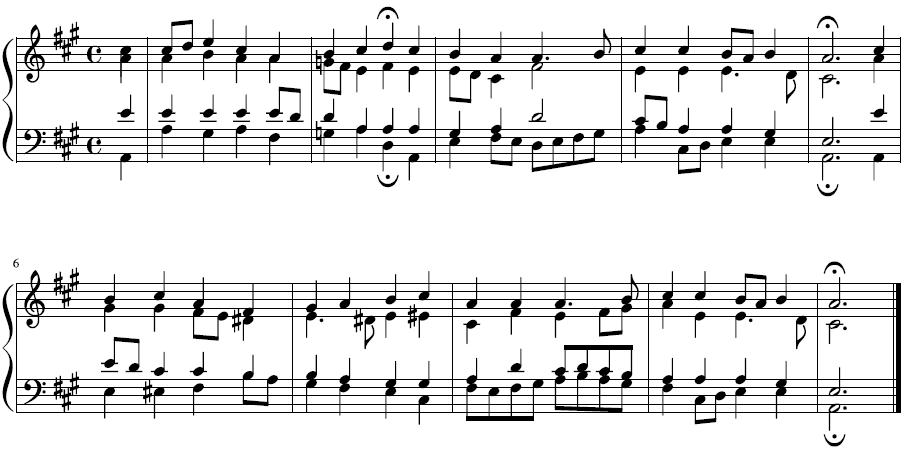Agency Negotiating Committee Co-Chair Chris Keyser explains in s 15-minute video.
(The WGA doesn't allow embedding; apologies.)
During the A-to-Z challenge, I discussed tempering, which is the art of tuning each note on the scale.
I'm a member of the Apollo Chorus of Chicago, and serve on its board. Every year since 1879, we've performed Händel's Messiah. Given the piece premiered in 1742, modern equal tempering would neither have been an option nor would it have sounded pleasing.
In a conversation yesterday with Dr. Stephen Alltop, our music director, I asked him what tuning we use. He replied:
We use an unequal temperament called Bach-Barnes. Messiah keys range from four sharps to four flats so I tweak the temperament to sound as good as possible in that range of harmonies.
So that's interesting. We perform an 18th-century work with 20th-century instruments using 21st-century tuning.
(We perform it next on December 15th and 16th at Harris Theater in Chicago.)
Washington Post columnist Charles Lane sees a disturbing connection between Jeopardy! champion's streak on the show and the data-driven approach that has made baseball less interesting:
People seem not to care that Holzhauer’s streak reflects the same grim, data-driven approach to competition that has spoiled (among other sports) baseball, where it has given us the “shift,” “wins above replacement,” “swing trajectories” and other statistically valid but unholy innovations.
Like the number crunchers who now rule the national pastime, Holzhauer substitutes cold, calculating odds maximization for spontaneous play. His idea is to select, and respond correctly to, harder, big-dollar clues on the show’s 30-square gameboard first. Then, flush with cash, he searches the finite set of hiding places for the “Daily Double” clue, which permits players to set their own prize for a correct response — and makes a huge bet. Responding correctly, Holzhauer often builds an insurmountable lead before the show is half over.
Dazed and demoralized opponents offer weakening resistance as his winnings snowball. And, with experience gained from each new appearance on the show, Holzhauer’s personal algorithms improve and his advantage grows.
In short, this professional gambler from Las Vegas does not so much play the game as beat the system. What’s entertaining about that? And beyond a certain point, what’s admirable?
Of course, Holzhauer’s strategy could not work without his freaky-good knowledge of trivia, just as baseball’s shift requires a pitcher skilled at inducing batters to hit into it. The old rules, though, would have contained his talent within humane channels. As it is, he’s set a precedent for the further professionalization of “Jeopardy!,” a trend which began 15 years ago with 74-time winner Ken Jennings.
If you enjoy watching nine batters in a row strike out until the 10th hits a homer, you’re going to love post-Holzhauer “Jeopardy!”
Also interesting is the timing: Charles van Doren died April 9th. He won the equivalent of $1.2m in 1957 by cheating on a game show.
 Here is the list of topics I wrote about for the 2019 Blogging A-to-Z challenge on the topic of music theory:
Here is the list of topics I wrote about for the 2019 Blogging A-to-Z challenge on the topic of music theory:
I posted all of them on time this year (7am Chicago time, noon UTC) except on April 13th. I'm quite proud of that. Last year I was less diligent.
I hope you've enjoyed the series. I'm looking forward to next April's topic, which I think you'll find timely and informative.
 Today the Blogging A-to-Z challenge comes to a close, and for the fourth time this year, I have to punt.
Today the Blogging A-to-Z challenge comes to a close, and for the fourth time this year, I have to punt.
Search all you want: music theory really doesn't have any important terms starting with Z. So today, I'm going to talk about one of my favorite vocal works: Brahms' opus 103, "Zigeunerlieder" (Gypsy Songs). I performed three songs from the cycle with the Illinois Music Educators Association All-State Honors Chorus in 1987, 100 years after Brahms wrote it. (Yes, back then I was one of the 256 best high-school age singers in the entire state. I am, right now, blowing on my fingernails.)
Enjoy it. As the score scrolls by, see how much of what I discussed this year you recognize. And enjoy it; it's a cool song cycle.
That's it for the A-to-Z challenge this year. Next April, I'll have a timely topic. Before then, I expect to publish my 7,000th blog entry (probably mid-October), take my 100,000th photograph (probably this month), and live my 18,000th day (almost certainly December 17th).
Thanks for reading!
 Our penultimate Blogging A-to-Z challenge post this year features the person in your life most likely to continue learning music theory: you.
Our penultimate Blogging A-to-Z challenge post this year features the person in your life most likely to continue learning music theory: you.
If you like music, go hear it. CDs and downloads are fine, but really you need to go out to hear live music as often as you can. Go hear the symphony; go to a garage band; toss a dollar in a busker's case in the subway. (You never know who might be performing down there.)
And keep learning how music works. This series has only skimmed the surface of music theory. The Web has several excellent sources for more depth: read Open Music Theory, take quizzes at MusicTheory.net, check out the Music Notation Project. Take a class at your local college. (In Chicago, DePaul and Northwestern have excellent music schools.)
Thanks for reading this series. I'll have a post for Z tomorrow, too.
 The Blogging A-to-Z challenge sometimes loses its way when the topic you want to write about doesn't really have anything interesting to say for one of the letters of the alphabet.
The Blogging A-to-Z challenge sometimes loses its way when the topic you want to write about doesn't really have anything interesting to say for one of the letters of the alphabet.
So let it be with X.
Further, it's finally spring in Chicago, so maybe the sunlight and warm weather have made me a little lazy.
To that point, let me just say that the xylophone is a percussion instrument with wood bars that you strike with a mallet to make sounds. Like this:
 Today's Blogging A-to-Z challenge entry examines the physics of music. Specifically, when a musician looks at a note on a page, what tone does she actually produce?
Today's Blogging A-to-Z challenge entry examines the physics of music. Specifically, when a musician looks at a note on a page, what tone does she actually produce?
Most people today have passing familiarity with the piano, which has one key per note. This means the frequency of each note remains the same no matter what key a pianist plays in. If she hits the A above middle C, the piano strings vibrate at 440 Hertz (cycles per second). The A below middle C is 220 Hz, the A below that is 110 Hz, and so on. All of the notes in between have fixed frequencies as well.
This system, dating from about the beginning of the 20th century, is called equal tempering. It has some pretty interesting consequences, first among them that only the octaves are perfectly in tune. Every other interval is slightly out of tune—sometimes in two ways.
Equal tempering is a compromise, driven in part by the popularity of the piano, because they're so hard to tune. Other instruments don't have this limitation, so in some circumstances (i.e., string quartets), you might hear well-tempering instead.
In well-tempered tuning, some intervals actually do retain their proper mathematical relationships. But only some. Well-tempering is another compromise, resulting in different keys having wildly different tone colors. Bach promoted well-tempering with his two-volume set of preludes and fugues called The Well-Tempered Clavier. (Cue the irony that most people today have never heard it played on a well-tempered instrument. I found a good demonstration of the differences between equal- and well-tempering that's worth 12 minutes of your time.)
Before well-tempering, musicians used Pythagorean tempering (based on perfect 5ths) and meantone tempering (imperfect 5ths to get better 3rds).
For more about this topic, Nathan Nokes has a good video about the physics of these earlier tuning systems, with pure-tone examples. Notice how just and Pythagorean temperaments sound out of tune. Except they're not; they're just different.
A large number of articles bubbled up in my inbox (and RSS feeds) this morning. Some were just open tabs from the weekend. From the Post:
In other news:
And now, to work, perchance to write...
 We're finally putting together a lot of what I've covered in this year's Blogging A-to-Z challenge. Today I'll touch on voice leading (known as "part writing" in the UK), which describes how individual voices in a composition work separately to create a musical whole.
We're finally putting together a lot of what I've covered in this year's Blogging A-to-Z challenge. Today I'll touch on voice leading (known as "part writing" in the UK), which describes how individual voices in a composition work separately to create a musical whole.
We already talked about counterpoint, in which we saw how two vocal lines interact while moving independently of each other. That's the essence of voice leading. But when you add more voices, the rules become a bit more complex.
Open Music Theory has a good explanation of the problems that voice leading aims to solve:
The “fundamental musical problems” we will address in the study of counterpoint center around the way in which some basic principles of auditory perception and cognition (how the brain perceives and conceptualizes sound) play out in Western musical structure. For example, our brains tend to assume that sounds similar in pitch or timbre come from the same source. Our brains also listen for patterns, and when a new sound continues or completes a previously heard pattern, it assumes that the new sound belongs together with those others. ... These abilities are also what allows music to have the emotional effect that it does on so many people. Whether or not a composer or songwriter is aware of the science and psychology of hearing, a masterful composer mediates and plays with these basic concepts.
In short, voice leading "leads the ear" in service of the music as a whole.
The general rules are:
- Favor small intervals
- Avoid crossing lines
- Avoid parallel fifths and octaves
Here's a simple example that demonstrates how each voice can have its own life and still form a cohesive whole:

So what's going on in there? All four lines have their own melodies (particularly the soprano and tenor lines), I've avoided parallel 5ths and octaves in a couple of tricky spots while still maintaining a decent chord progression, and none of the lines cross—though they do, occasionally, trade notes. Notice the tenor D on the second beat of the 3rd measure followed by the alto D in the next beat.
(There's also a joke buried in there. Play each of the vocal lines separately and you'll find it. The joke explains why there's a bit of clunkiness between the second and third measures.)
But that's just me demonstrating a concept. Here's what a genius does, in the first of his nearly 400 surviving chorales:

(Bonus pdf file.)